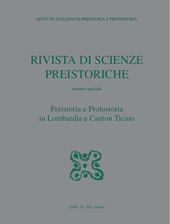L'età del Rame in Lombardia
P. 253-269
After a brief review of the history of research in Lombardy, which first developed in the second half of the 19th century and in recent decades has included the excavation of a number of settlements, cult and ceremonial sites and (fewer) cemeteries, the chronology of the Copper Age – based on a series of radiometric determinations – is given. It began early here, in the last centuries of the first half of the 4th millennium BC, and lasted until the end of the 3rd millennium, when new settlement strategies – with regard to choice of geographical location and the nature of the villages – are widely found. It should be noted that – in contrast to a widespread reliance on funerary studies – in the many rescue digs and excavations carried out prior to construction work, as well as targeted excavations, settlement sites have been in the majority.
These have varied geographic locations (the plain, hilly areas, lakesides, valleys), and may be multiphase or single phase, continuously inhabited since the Neolithic, and persist until the end of the first phase of the Early Bronze Age. The foothills and valleys are better known since more research has been carried out there. Copper Age burial sites consist of the old, well known graveyards discovered in the Brescia Province Po Plain areas, and caves and rock-shelters with redeposited remains in the Alpine foothills (the “Civate” Group) which belong to a widespread cultural phenomenon that in north Italy involves Lombardy, Trentino, Veneto and Liguria.
With regard to this second group, important sites such as the Valtenesi rock-shelter (Manerba del Garda) studied by the late L. H. Barfield (2007) and more recent work (Corna Nibbia, Bione) have involved the combined study of finds and human remains, furnishing precise dating and a detailed picture of these complex cultural funerary practices. Light is also thrown on belief systems by the numerous sanctuaries with engraved standing stones present in Valtellina and Valle Camonica. Burial grounds and sanctuaries share many common features which derive from a single ideological structure. [Publisher's text]
-
Articles from the same issue (available individually)
-
Information
DOI: 10.32097/1174
ISSN: 2282-457X


